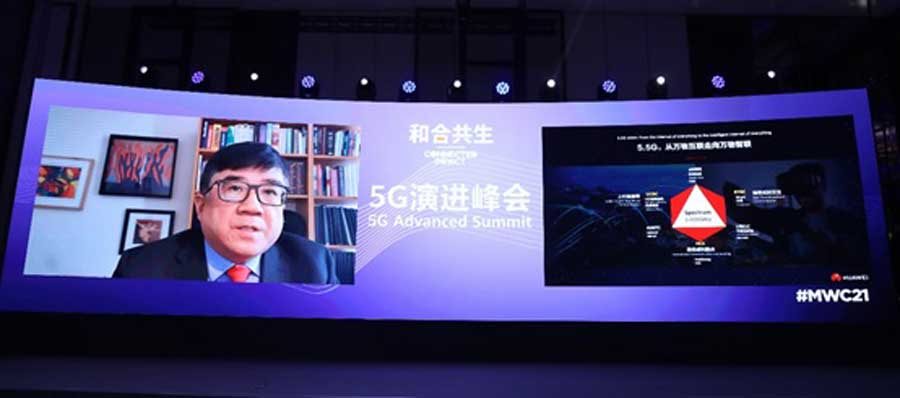In his speech, Dr. Tong emphasized that 5G must continuously evolve to build an engine of all-industry digitalization so as to satisfy the fast-growing consumer connections and diverse industrial applications.
5G development accelerates, driving 5G networks to improve performance
A new communication technology generally dominates for a decade, evolving to provide stronger capabilities, before being superseded by the next generation.
In the past year, 5G has been evolving at a faster rate, showing its massive potential.
The continuous improvement of experience in customer connections and enrichment of Internet of Things (IoT) services raise the requirements on connection capabilities.
"The ever-increasing demand for wireless connections is the fundamental driving force to continuously advance mobile technologies," said Dr. Tong.
Therefore, 5G must constantly improve its capabilities.
Enhanced Mobile Broadband (eMBB) services are driving a significant upsurge in data demand, requiring 5G networks to increase capacity to guarantee premium experience.
With the introduction of reduced capability (REDCAP), massive Machine-Type Communications (mMTC) services will be available on more terminals to fulfill the massive diverse IoT requirements.
Ultra-reliable low-latency communication (URLLC) services require networks to reduce transmission latency and provide latency-guaranteed connection services so as to meet the high-quality connection requirements of remote and programmable logic controller (PLC) control.
5G must expand its boundary of capabilities to open up a new space of business
As new applications keep emerging in the market, the three use cases originally defined in 5G need enhancement to meet diverse IoT service requirements.
The boundary of 5G capabilities must be expanded to open up a new space of business.
Immersive interaction services are rapidly developing.
5G AR/VR has enabled superior virtual experience.
With the rise of lightweight XR devices, 5G XR will also become a reality.
This requires 5G to be further enhanced to deliver premium immersive experiences.
5G networks will be required to increase its average speed from 120 Mbps to 2 Gbps as high definition improves from 4K to 16K.
To ensure real-time interaction in the virtual world, 5G must also further reduce transmission latency from the current 20 ms to 5 ms.
Uplink-centric networks are accelerating industrial digitalization.
Currently, 5G applications are growing at an unprecedented rate, raising the requirements on uplink speeds.
Various consumer AR/XR services require high-definition images and videos to be sent from local devices to clouds for further rendering.
Remote control and machine vision in industrial applications also require real-time transfer of 4K and 8K videos.
This will lead to a considerable increase in the proportion of uplink traffic over 5G networks to above 40%.
To deal with such a huge amount of uplink traffic, 5G uplink capabilities must be improved by at least 10 times.
In addition, 5G must provide sensing capabilities to empower remote control, vehicle-road synergy, unmanned transportation, and smart logistics.
For example, by introducing cellular Massive MIMO's beam sweeping to sensing technologies, both sensing and communication, and even indoor high-precision positioning services, can be implemented through wireless technologies.
5.5G will become an engine of all-industry digitalization
Based on its abundant practices while helping realize the prospects in the mobile industry, Huawei has proposed 5.5G to contribute to exploring new applications, including uplink centric broadband communication (UCBC), real-time broadband communication (RTBC), and harmonized communication and sensing (HCS), with the aim to build an engine of all-industry digitalization.
"Both technology and business are essential to stimulate and promote the development of an industry.
The mobile industry, the world's largest wireless connection market, reaches trillions of US dollars every year," said Dr. Tong.
"The accelerating integration of 5G with various industries will create a new market space worth more than US$10 trillion."
Due to the lack of collaboration between the connection technologies of industrial services, the applications are often limited to just a single or several applications, far from a scaled effect.
As a result, the market is worth just billions of US dollars.
The continuous evolution of 5G will improve network capabilities and expand service scenarios, adding extra support for achieving the integration while reducing the cost of connections.
This will help unleash the potential business opportunities worth over US$100 billion in the IoT industry.
"The innovation of technologies and applications will open up infinite possibilities for 5G evolution in the next decade," Dr. Tong concluded.
"The wireless communications industry cannot achieve success without unified standards and industrial collaboration.
Together, we should define 5G evolution and promote industrial collaboration to accelerate the maturity of technology and build a sustainable future with 5G."
























